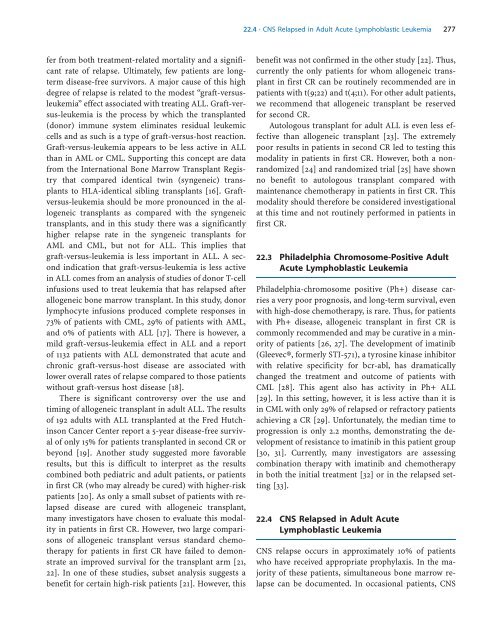Acute Leukemias - Republican Scientific Medical Library
Acute Leukemias - Republican Scientific Medical Library
Acute Leukemias - Republican Scientific Medical Library
You also want an ePaper? Increase the reach of your titles
YUMPU automatically turns print PDFs into web optimized ePapers that Google loves.
a 22.4 · CNS Relapsed in Adult <strong>Acute</strong> Lymphoblastic Leukemia 277<br />
fer from both treatment-related mortality and a significant<br />
rate of relapse. Ultimately, few patients are longterm<br />
disease-free survivors. A major cause of this high<br />
degree of relapse is related to the modest “graft-versusleukemia”<br />
effect associated with treating ALL. Graft-versus-leukemia<br />
is the process by which the transplanted<br />
(donor) immune system eliminates residual leukemic<br />
cells and as such is a type of graft-versus-host reaction.<br />
Graft-versus-leukemia appears to be less active in ALL<br />
than in AML or CML. Supporting this concept are data<br />
from the International Bone Marrow Transplant Registry<br />
that compared identical twin (syngeneic) transplants<br />
to HLA-identical sibling transplants [16]. Graftversus-leukemia<br />
should be more pronounced in the allogeneic<br />
transplants as compared with the syngeneic<br />
transplants, and in this study there was a significantly<br />
higher relapse rate in the syngeneic transplants for<br />
AML and CML, but not for ALL. This implies that<br />
graft-versus-leukemia is less important in ALL. A second<br />
indication that graft-versus-leukemia is less active<br />
in ALL comes from an analysis of studies of donor T-cell<br />
infusions used to treat leukemia that has relapsed after<br />
allogeneic bone marrow transplant. In this study, donor<br />
lymphocyte infusions produced complete responses in<br />
73% of patients with CML, 29% of patients with AML,<br />
and 0% of patients with ALL [17]. There is however, a<br />
mild graft-versus-leukemia effect in ALL and a report<br />
of 1132 patients with ALL demonstrated that acute and<br />
chronic graft-versus-host disease are associated with<br />
lower overall rates of relapse compared to those patients<br />
without graft-versus host disease [18].<br />
There is significant controversy over the use and<br />
timing of allogeneic transplant in adult ALL. The results<br />
of 192 adults with ALL transplanted at the Fred Hutchinson<br />
Cancer Center report a 5-year disease-free survival<br />
of only 15% for patients transplanted in second CR or<br />
beyond [19]. Another study suggested more favorable<br />
results, but this is difficult to interpret as the results<br />
combined both pediatric and adult patients, or patients<br />
in first CR (who may already be cured) with higher-risk<br />
patients [20]. As only a small subset of patients with relapsed<br />
disease are cured with allogeneic transplant,<br />
many investigators have chosen to evaluate this modality<br />
in patients in first CR. However, two large comparisons<br />
of allogeneic transplant versus standard chemotherapy<br />
for patients in first CR have failed to demonstrate<br />
an improved survival for the transplant arm [21,<br />
22]. In one of these studies, subset analysis suggests a<br />
benefit for certain high-risk patients [21]. However, this<br />
benefit was not confirmed in the other study [22]. Thus,<br />
currently the only patients for whom allogeneic transplant<br />
in first CR can be routinely recommended are in<br />
patients with t(9;22) and t(4;11). For other adult patients,<br />
we recommend that allogeneic transplant be reserved<br />
for second CR.<br />
Autologous transplant for adult ALL is even less effective<br />
than allogeneic transplant [23]. The extremely<br />
poor results in patients in second CR led to testing this<br />
modality in patients in first CR. However, both a nonrandomized<br />
[24] and randomized trial [25] have shown<br />
no benefit to autologous transplant compared with<br />
maintenance chemotherapy in patients in first CR. This<br />
modality should therefore be considered investigational<br />
at this time and not routinely performed in patients in<br />
first CR.<br />
22.3 Philadelphia Chromosome-Positive Adult<br />
<strong>Acute</strong> Lymphoblastic Leukemia<br />
Philadelphia-chromosome positive (Ph+) disease carries<br />
a very poor prognosis, and long-term survival, even<br />
with high-dose chemotherapy, is rare. Thus, for patients<br />
with Ph+ disease, allogeneic transplant in first CR is<br />
commonly recommended and may be curative in a minority<br />
of patients [26, 27]. The development of imatinib<br />
(Gleevec®, formerly STI-571), a tyrosine kinase inhibitor<br />
with relative specificity for bcr-abl, has dramatically<br />
changed the treatment and outcome of patients with<br />
CML [28]. This agent also has activity in Ph+ ALL<br />
[29]. In this setting, however, it is less active than it is<br />
in CML with only 29% of relapsed or refractory patients<br />
achieving a CR [29]. Unfortunately, the median time to<br />
progression is only 2.2 months, demonstrating the development<br />
of resistance to imatinib in this patient group<br />
[30, 31]. Currently, many investigators are assessing<br />
combination therapy with imatinib and chemotherapy<br />
in both the initial treatment [32] or in the relapsed setting<br />
[33].<br />
22.4 CNS Relapsed in Adult <strong>Acute</strong><br />
Lymphoblastic Leukemia<br />
CNS relapse occurs in approximately 10% of patients<br />
who have received appropriate prophylaxis. In the majority<br />
of these patients, simultaneous bone marrow relapse<br />
can be documented. In occasional patients, CNS
















